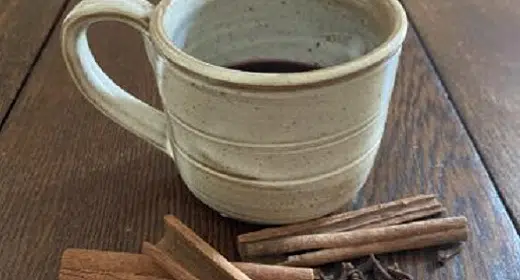by Julia Skinner: Tasty, healthy drink, and a bit of history too…
Mulled wine is a popular winter drink, used to chase away chills during the winter months and add a festive touch to holiday gatherings. But it’s not all fun and games: Mulled wine was originally a serious medicine called Hippocras, with a history stretching all the way back to Ancient Greece and Rome.
Get Your Greek On
As the name suggests, Hippocras (or Hipocras, Ipocras, or Ypocras, depending who you ask) is named after the Ancient Greek physician Hippocrates, who first proposed humoral theory in the fifth century BCE, though it was not formalized into a medical system until centuries later and the work by Roman physician Galen. In humoral medicine, the medical system popular in Europe from the Classical period (Ancient Greece and Rome) up through the 19th century, wine was a popular health tonic, with different styles of wine being prescribed for different ailments.

Sense of Humors
Humoral medicine is based upon four humors: melancholic, phlegmatic, choleric, and sanguine, all connected to different bodily fluids (humors), seasons, planets, organs, elements, and personality traits. Humoral medicine is highly personalized and views treatments at the individual level: Each person presents a different blend of humors, and the key to health is keeping these humors in balance.
Each humor embodies a different quality (hot, cold, moist, or dry), and different foods are connected to those qualities and therefore to certain humors (e.g. foods that are hot and dry promote yellow bile). This applied to drinks, too, and a hot, dry wine as well as hot, dry food (like mustard or lemon juice) might be given to someone with cold, moist tendencies.
Humoral theory informed how people would prepare their foods too, and so warming up wine would change how it might affect one’s humors. But drinking warm wine had a practical benefit, too: warming up your wine to enjoy on a cold night helped you stay warm, too.


Spicey!
We do know that sweetened, spiced wine was consumed in the ancient world (in Rome it was called Conditum Paradoxum), there’s no proof that Hippocrates himself invented it. The Hippocras that we know comes from the early medieval period, and one historian says it got its name not only because of its health benefits, but because the spices were strained using a cloth bags called a manicum Hippocraticum–“the sleeve of Hippocrates” (so called because, according to legend, he used to strain his preparations through his voluminous sleeves). This spiced wine was common in Medieval France and Spain, spreading elsewhere in Europe, making its way to England and later to Germany and the Nordic countries.
In some cases, it would be made with milk, which would curdle on contact with the acidity of the wine and clarify it by capturing sediment and particles from the spices in that curdling process. It was often syrupy and sweet (sometimes sweetened with expensive imported sugar, but often with more affordable domestic honey). For our recipe, I’ve offered an unsweetened spiced wine as well as a sweetened version. I typically prefer the unsweetened version, though I recognize it’s not truly historically accurate. I’ve also put our whole spices in a cheesecloth bundle rather than straining through a conical mesh bag. Either is fine, though if you strain it make sure you give it a few passes to remove all the spices.

There are many, many iterations of Hippocras out there in the world: Some containing a variety of medicinal local plants, some containing cream and a ton of sugar, as well as different flavor profiles from different regions. But they all have one thing in common, and that’s imported spices. Specifically, cinnamon, nutmeg, and clove are ones I see most often, though ginger and mace (a spice from the outside of the nutmeg nut) are also pretty common.
Middle-Aged
Because of this, medieval Hippocras would have been pretty much a beverage common to the upper classes: Spices were expensive, and though some middling families did have some spices, they were used sparingly and would have been an unlikely daily beverage addition. That said, middling households did like sweets and would sometimes have spiced wine, particularly as the spices helped impart flavor and sweetness to dry wines or those that were beginning to get a bit vinegar-y. I’ve seen varying accounts regarding how often this happened, from “people of all classes drank spiced wine regularly” to “only the wealthy did.” The truth is almost certainly somewhere in between.
Hippocras was traditionally served as an after-dinner digestive with wafers, and was gradually replaced by stronger spirits that served as the precursors of modern day liqueurs. By the 18th century it was considered old-fashioned, but it did not go away, it simply was rebranded.
Christmas markets, particularly in Germany, started to emerge in the 19th century, and vendors realized that giving visitors warm beverages kept them comfortable and hopefully more likely to keep shopping. Sweet, spiced mulled wine came to the rescue. “Mulling” simply means to steep, and so this warm, spice-steeped wine we drink each winter is actually just ancient medicine by another name.
We’re making a version from Robert May’s Queen’s Closet Opened, an Early Modern text (1656) that appeared at the tail end of the beverage’s popularity. May offers a couple different versions (one with cream and mace, one without cream and with rosemary instead of mace). For simplicity’s sake, I’ve opted for the simple steeping method of the second, rather than clarifying with dairy as his first one does. You can make this with red or white wine, but I think it works much better with red.

While mulled wine today is served warm, hippocras can be served warm or cold.
Hippocras
2 sticks cinnamon
1 sprig fresh rosemary
1 inch knob of fresh ginger, peeled (it’s easiest to peel if you turn a spoon upside down and use the edge to scrape the peel from the ginger)
1 nutmeg nut (I score this a few times around the outside with a microplane to help it release its flavor)
1 tsp whole cloves
1 tsp black peppercorns
Cheesecloth
¾ c granulated sugar, optional
1 bottle red wine (claret will be most historically accurate, but pick whatever you like the flavor of)
-Cut off a square of cheesecloth and lay flat
-Place spices in the middle, and tie up into a secure bundle.
-Place your bundle in the bottom of a food safe container and add your sugar (if using) and wine.
-Allow to sit out for 24 hours to infuse
-Remove spices, give a quick stir (and another strain, if needed), and serve.



















































